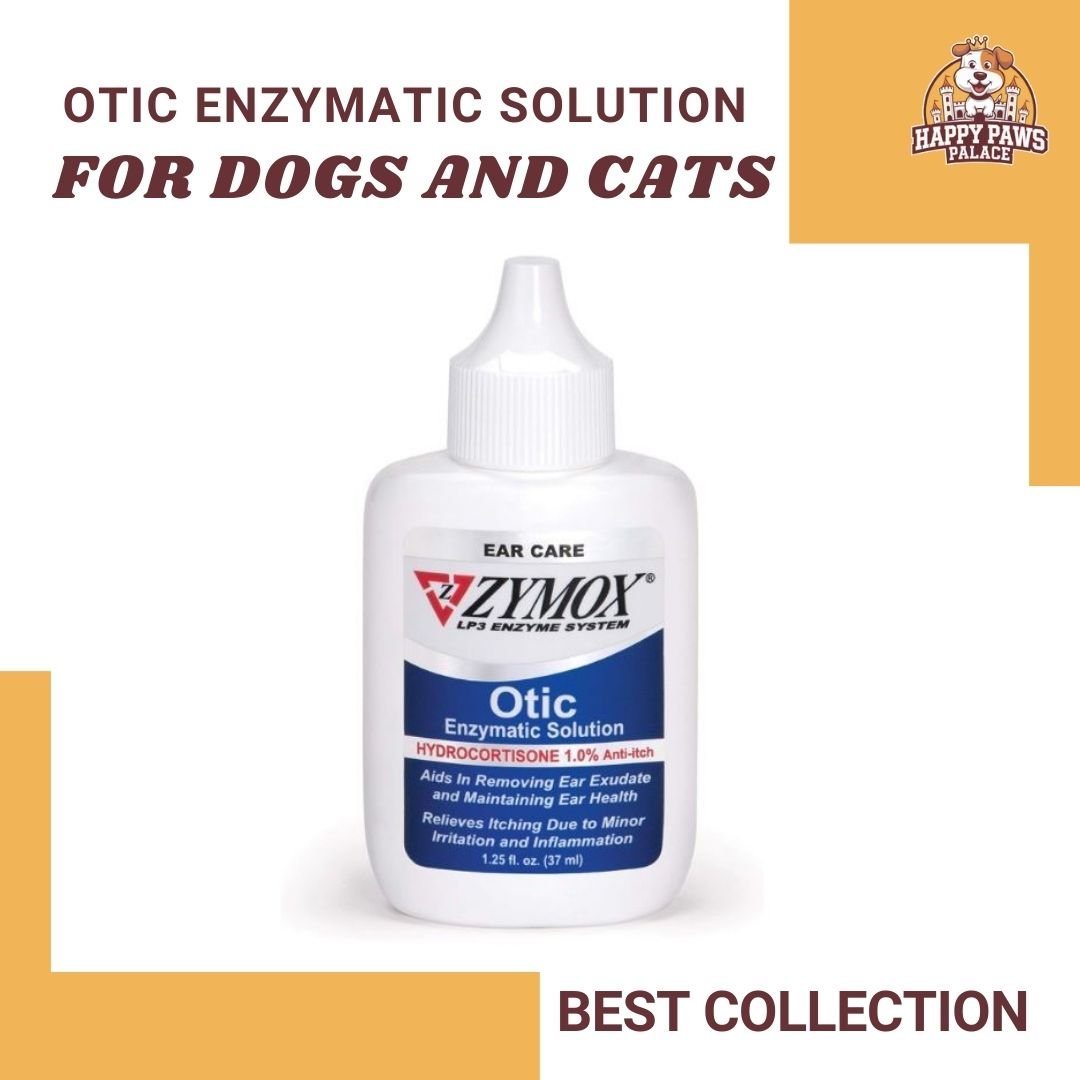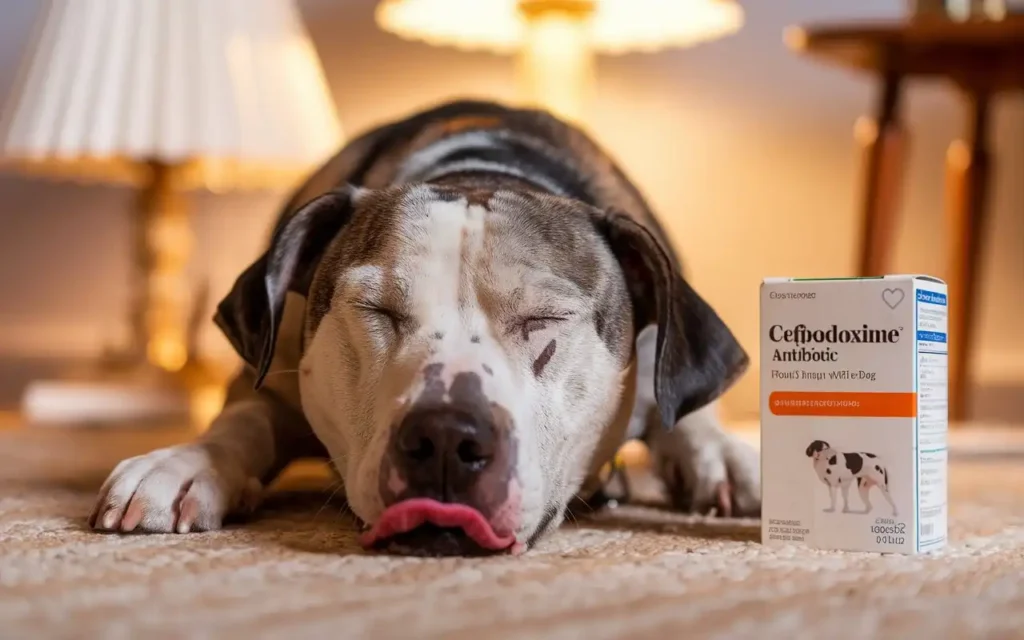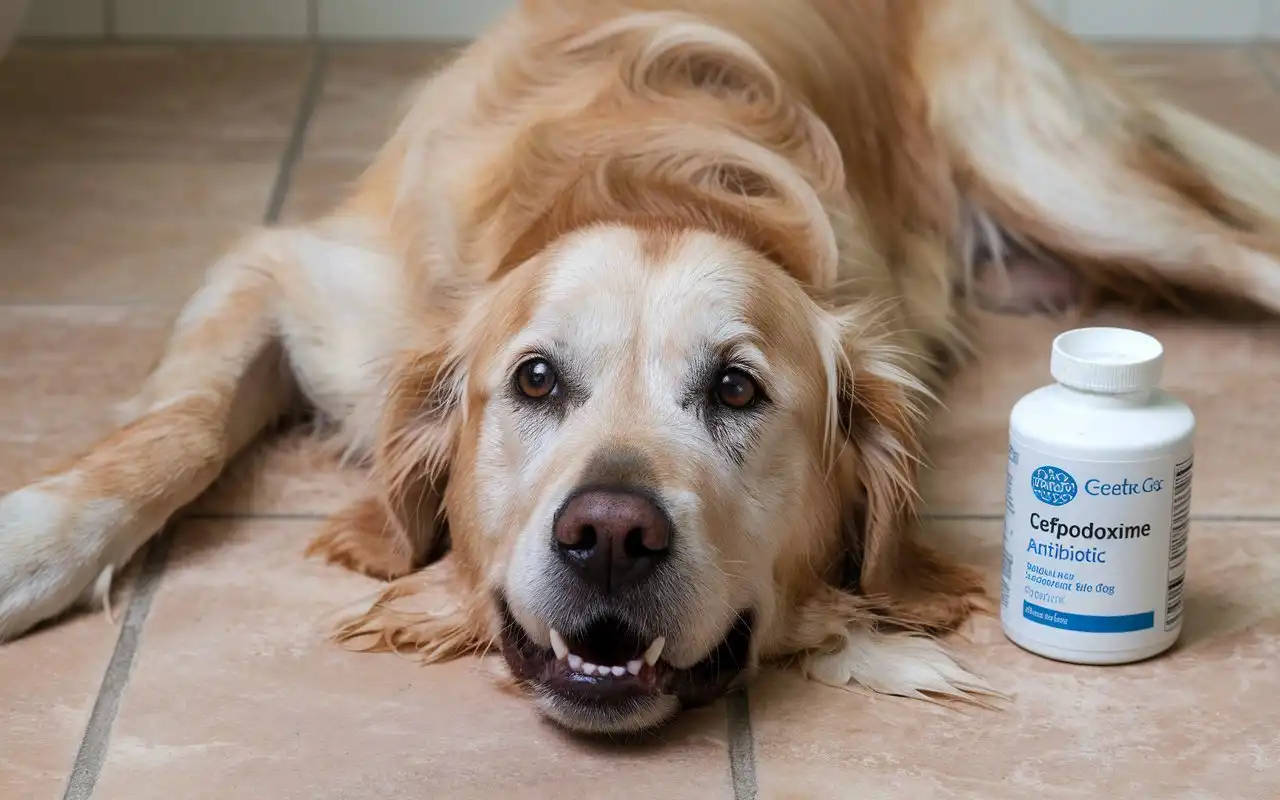Cefpodoxime is a trusted antibiotic for dogs. It’s often prescribed to treat bacterial infections because it works well and is easy to use. Cefpodoxime is usually given once daily. Other antibiotics need multiple doses each day. This simplifies the treatment for both pets and their owners. If your dog has been prescribed this medication, you may have questions. You may wonder about its uses, side effects, proper dosages, and what to expect during treatment. This guide covers what pet owners need to know about cefpodoxime. It includes why vets choose it, how it works, and safe usage protocols.
Table of Contents
What is Cefpodoxime?
Cefpodoxime for dog is a cephalosporin, a type of antibiotic. It is used to treat bacterial infections in humans and animals. Cefpodoxime is a third-generation cephalosporin. It works against many bacteria. So, it is effective for several types of infections. It prevents bacteria from growing by interfering with their cell walls. This helps the dog’s immune system eliminate the infection.
In veterinary medicine, cefpodoxime is popular. It treats many infections, is well tolerated, and has a long-lasting effect. It comes in tablet and liquid forms. This lets vets choose the best way to give it, based on the dog’s condition and ease of use.
Understanding Antibiotics for Pets
Antibiotics like cefpodoxime. But, they must be used responsibly. This will maximize their benefits and reduce risks. Misusing antibiotics can cause antibiotic resistance. This makes bacteria harder to treat later. Examples of misuse include giving an incomplete dose or using them without a vet’s guidance. It’s also essential to tell bacterial and viral infections apart. Antibiotics like cefpodoxime are ineffective against viruses. Always consult a vet before giving antibiotics. Ensure cefpodoxime for dogs is the best choice for your pet’s health.



Why is Cefpodoxime Prescribed for Dogs?
Veterinarians often prescribe cefpodoxime for dogs. It is effective and treats many bacterial infections. Once-daily dosing is convenient. It’s ideal for pet owners who may struggle with more frequent schedules. If a bacterial infection is suspected, cefpodoxime may be prescribed. This would be based on initial symptoms, even before lab results. This is common when prompt action is vital to the dog’s health. For example, skin or respiratory infections could worsen if untreated.
Veterinarians also value cefpodoxime’s broad spectrum of activity. Cefpodoxime for dogs can help with infections, whether localized or systemic. It can contain and kill the bacteria, relieving symptoms and aiding recovery.
Conditions Treated by Cefpodoxime
Skin Infections
Skin infections are among the most common reasons for prescribing cefpodoxime. Dogs can develop skin infections due to cuts, scrapes, or bites that become contaminated with bacteria. These infections often cause itching, redness, and swelling, which can be uncomfortable and even painful for the dog. Cefpodoxime treats common skin conditions like pyoderma and abscesses. Pyoderma is a bacterial skin infection. An abscess is a pus-filled infection under the skin.
Cefpodoxime helps with skin infections. It kills the bacteria causing the pain. Cefpodoxime, with topical treatments, hygiene, and wound care, aids healing and prevents infection.
Urinary Tract Infections (UTIs)
Urinary tract infections (UTIs) in dogs can be uncomfortable and, if untreated, may lead to severe kidney issues. UTI symptoms include frequent urination, straining to urinate, blood in the urine, and pain during urination. Cefpodoxime for dogs targets the bacteria causing the infection. This allows the urinary system to heal and reduces the symptoms.
UTIs can recur in some dogs. So, vets may recommend lifestyle changes, more hydration, or preventive care with cefpodoxime. This is to keep urinary tracts healthy.
Respiratory Infections
Cefpodoxime for dogs often treats bacterial respiratory infections in dogs. These can include bronchitis, pneumonia, and sinusitis. Signs of respiratory infections include coughing, nasal discharge, fever, and lethargy. Cefpodoxime kills the bacteria. This helps the dog breathe and regain energy.
Prompt treatment of respiratory infections is crucial. Untreated cases may lead to severe conditions or complications. Cefpodoxime treats respiratory infections. It helps dogs recover faster and avoid long-term issues.

How Cefpodoxime Works in Dogs
Cefpodoxime for dogs works by targeting the bacteria’s cell wall synthesis. It’s vital for bacterial growth and reproduction. Without a stable cell wall, bacteria cannot survive, which makes cefpodoxime especially effective. This antibiotic stops bacteria from replicating. It allows the immune system to clear the infection faster.
Once in the bloodstream, cefpodoxime reaches the infection site. It then kills bacteria for 24 hours. This long action period is beneficial for owners and dogs alike, as it means only one dose per day is needed. The consistency in dosing is critical to ensure the bacteria do not have an opportunity to develop resistance or regain strength.
Cefpodoxime Dosage for Dogs
A veterinarian determines the right dose of cefpodoxime. They consider the dog’s weight, age, health, and infection severity.
Dosage Based on Weight
The standard dosage for cefpodoxime in dogs is approximately 2.3 to 4.5 mg per pound of body weight, administered once daily. For example, a 20-pound dog might receive a dose ranging between 46 and 90 mg per day. However, always follow your vet’s instructions. They may adjust the dose based on the infection type and your pet’s response.
Frequency of Administration
Cefpodoxime is typically given once every 24 hours, thanks to its sustained action over this period. This dosing frequency is convenient for most pet owners and reduces the risk of missed doses. It’s vital to give the medication at the same time each day. This keeps levels in the bloodstream steady and supports healing.
Administer Cefpodoxime to Your Dog
Cefpodoxime for dogs is available in tablet and liquid forms, and the best choice depends on the dog’s needs and the owner’s preference. The tablet can be given directly by hand or hidden in a treat if your dog is reluctant to take medicine. If using liquid cefpodoxime, measure the dose carefully to ensure accuracy.
Administering cefpodoxime with food may reduce mild stomach upset. It is effective without food, too. Make sure your dog swallows the entire dose, as partial dosing can reduce effectiveness.
Precautions and Warnings
While cefpodoxime is generally safe, certain precautions are important. Dogs allergic to cephalosporins or penicillins should avoid cefpodoxime. They may have an adverse reaction. Signs of an allergic response include swelling, hives, or difficulty breathing.
Tell your vet about any other meds or supplements your dog takes. This will help prevent drug interactions. Don’t give cefpodoxime if your dog is taking antacids. They can reduce its absorption and effectiveness.
Possible Side Effects of Cefpodoxime in Dogs
While cefpodoximefor dogs is generally safe, like all medications, it can cause side effects in some dogs. Being aware of these potential reactions can help pet owners recognize if something isn’t quite right and respond promptly.
Common Side Effects
The most common side effects of cefpodoxime for dogs are typically mild and often related to the digestive system. These include symptoms like nausea, diarrhea, or occasional vomiting. Many of these side effects are temporary and may resolve on their own as your dog adjusts to the medication. If you’re concerned about these reactions, try giving cefpodoxime for dogs with food to lessen stomach irritation.
It’s also helpful to keep an eye on your dog’s eating and bathroom habits while they’re on cefpodoxime. Mild digestive issues are usually not a concern. But if symptoms persist, consult your vet to ensure the medication is tolerated.
Serious Side Effects
Though rare, some dogs may have serious side effects. These need immediate veterinary attention. These may include:
- Allergic Reactions: Allergic reactions can cause swelling, hives, itching, or trouble breathing. Allergic reactions to antibiotics are rare but can be severe.
- Severe Gastrointestinal Distress: Serious reactions may cause vomiting, bloody diarrhea, or a lack of appetite. Call the vet immediately.
It’s vital to address any serious side effects quickly. Your vet may adjust the medication or suggest an alternative if needed.

Cefpodoxime Interactions with Other Medications
Cefpodoxime may interact with some medications. This could reduce its effectiveness or increase side effects. Tell your vet about any other medications your dog takes, including OTC supplements. This will help avoid potential issues.
Some common interactions include:
- Other Antibiotics: Cefpodoxime may reduce other antibiotics’ effectiveness and raise side effects when used with them.
- Antacids: Antacids can interfere with the absorption of cefpodoxime, making it less effective. Avoid giving antacids close to cefpodoxime doses unless directed by your vet.
- Blood Thinners: Cefpodoxime may interact with blood thinners. So, disclose all medications to your vet.
Your vet will consider these interactions. They will adjust the treatment plan to ensure your dog gets the best care.
Alternatives to Cefpodoxime for Dogs
If cefpodoxime for dogs isn’t suitable due to allergies or reactions, your vet may suggest other antibiotics. Each alternative has its own strengths, and the best option depends on the specific infection and the dog’s individual needs.
Amoxicillin
Amoxicillin is a commonly used antibiotic for treating bacterial infections in dogs. Like cefpodoxime, it is effective against many types of bacteria and is generally well tolerated. However, it may need to be administered more frequently, as its effects don’t last as long as cefpodoxime’s once-daily dosing.
Doxycycline
Doxycycline is a broad-spectrum antibiotic. It is often used for respiratory infections, tick-borne diseases, and some skin conditions. Doxycycline works differently from cefpodoxime. So, it can treat infections where cefpodoxime may not be effective.
Clindamycin
Clindamycin is an antibiotic often prescribed for infections in bones, teeth, and soft tissues. It is a viable alternative if cefpodoxime for dogs is not suitable for treating certain types of infections. However, clindamycin may cause digestive issues. So, vets carefully weigh its benefits and side effects before prescribing it.
Your vet will choose the best option. They will consider the infection’s type, location, and severity, as well as your dog’s health history.
How Long Should Your Dog Take Cefpodoxime?
The duration of cefpodoxime treatment varies based on the severity of the infection and your dog’s response to the medication. In general, most cefpodoxime courses last between 7 and 14 days. However, severe infections may need longer treatment. This is to ensure that the bacteria are completely gone.
It’s crucial to follow your vet’s instructions on how long to treat. If your dog seems better after a few days, don’t stop the medication. It could cause the infection to return or contribute to antibiotic resistance. Always complete the full prescribed course to maximize the chances of a full recovery.
What to Consider if You Skip a Dose
If you miss a dose of cefpodoxime, administer it as soon as you remember. If it’s close to the next dose, skip the missed one. Resume the regular schedule. Never double up on doses. It can raise the risk of side effects and won’t improve treatment.
Missing a single dose is usually not a cause for concern, but consistency is essential for optimal results. A daily reminder or a pill organizer can help ensure your dog gets their medicine on time.
Cost and Availability of Cefpodoxime for Dogs
Cefpodoxime for dogs is widely available at vet offices and some pet pharmacies. Its cost can vary depending on factors such as dosage, quantity, and pharmacy location. Generally, cefpodoxime is considered affordable, especially for short-term treatment courses. Many pet owners find it a cost-effective solution for treating bacterial infections in dogs.
Some pet insurance plans may cover cefpodoxime. This is if it’s for a medically necessary condition. Check with your pharmacy or vet for pricing. Ask about discounts or rebates.
Conclusion
Cefpodoxime for dogs is a reliable and effective antibiotic that can treat a range of bacterial infections in dogs. When used as directed by a veterinarian, it offers substantial benefits with minimal risk. By following the vet’s instructions and watching for side effects, pet owners can help their dogs recover. They must also finish all the medicine. Antibiotics like cefpodoxime should only be used under a vet’s guidance. This ensures they are used effectively and responsibly.






